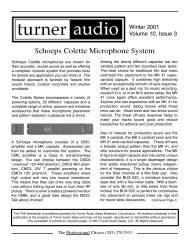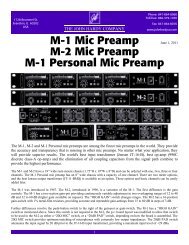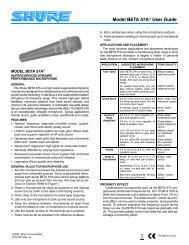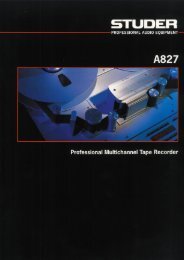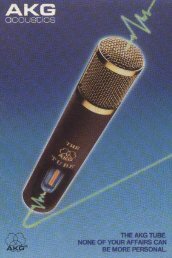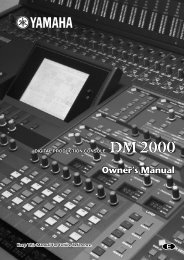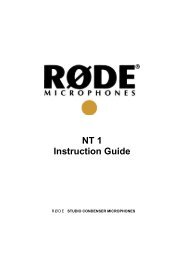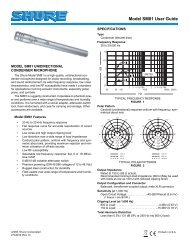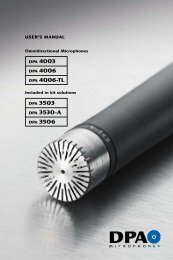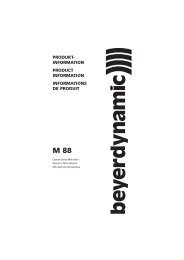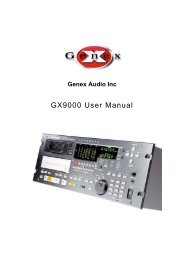Lexicon 480L | PDF - Freeverb3
Lexicon 480L | PDF - Freeverb3
Lexicon 480L | PDF - Freeverb3
Create successful ePaper yourself
Turn your PDF publications into a flip-book with our unique Google optimized e-Paper software.
Banks 11-12: the Random Halls and Spaces Program<br />
SPREAD<br />
SPREAD works together with SHAPE to control the<br />
contour of the overall ambience of the sound created<br />
by the <strong>480L</strong>. SPREAD controls the duration of the initial<br />
contour of the reverberation envelope (SHAPE controls<br />
the envelope). Low SPREAD settings result in a<br />
rapid onset of reverberation at the beginning of the<br />
envelope, with little or no sustain. Higher settings<br />
spread out both the buildup and sustain.<br />
SPREAD and SHAPE control the rate at which reverberation<br />
builds up, and how the reverberation sustains<br />
as it begins to decay. When DECAY OPT is in Reverb<br />
mode, SPREAD is linked to SIZE, and the actual value<br />
for SPREAD depends on the selected SIZE. Parameters<br />
are unlinked in Effect mode.<br />
SIZE<br />
SIZE sets the rate of buildup of diffusion after the initial<br />
period (which is controlled by DIFFUSION). It also acts<br />
as a master control for RT MID and SPREAD. For this<br />
reason, the SIZE control can be used to vary a reverb<br />
sound from very large to very small. Generally, you<br />
should set the SIZE control to approximate the size of<br />
the acoustic space you are trying to create. The size in<br />
meters is roughly equal to the longest dimension of the<br />
space. Moving SIZE while a signal is present momentarily<br />
mutes the reverb signal.<br />
The apparent size of the space created is actually a<br />
combination of the settings of the SIZE, SHAPE, and<br />
SPREAD controls. Small acoustic spaces are characterized<br />
by a rapid buildup of diffusion. However, both<br />
small and large spaces frequently have an uneven<br />
buildup of initial reverberation. This uneven buildup is<br />
what is controlled by the SPREAD and SHAPE controls.<br />
HF CUTOFF<br />
HF CUTOFF sets the frequency above which a 6 dB/<br />
octave low-pass filter attenuates the processed signal.<br />
It attenuates both preechoes and reverberant sound.<br />
High frequencies are often rolled off with this parameter,<br />
resulting in more natural sounding reverberation.<br />
PREDELAY<br />
PREDELAY adjusts an additional time delay between<br />
the input of signal and the onset of reverberation. The<br />
control is not intended to mimic the time delays in<br />
natural spaces. In real rooms the build-up of reverberation<br />
is gradual, and the initial time gap is usually<br />
relatively short. Natural spaces are best emulated by<br />
setting SHAPE at a middle value and adjusting<br />
SPREAD for the desired effective pre-delay.<br />
Additional delay added with the PREDELAY control<br />
can increase the initial time gap slightly, emulating a<br />
situation where reverberant pick-up microphones are<br />
located much further from the source than the main<br />
microphones. If less than about 30ms of pre-delay is<br />
added, this additional delay can add clarity with some<br />
music, but it can also sound unnatural. Large predelays<br />
can be useful for slap-echo effects.<br />
Note: Very high values of PREDELAY limit the amount<br />
of SPREAD available. The display, however, does not<br />
reflect this.<br />
Page Two<br />
BASS MULTIPLY<br />
BASS MULTIPLY sets the reverb time for low-frequency<br />
signals, as a multiplier of the RT MID parameter.<br />
For example, if BASS MULTIPLY is set to 2X, and<br />
RT MID is set to two seconds, the low frequency reverb<br />
time will be four seconds. For a natural-sounding hall<br />
ambience, we recommend values of 1.5X or less.<br />
CROSSOVER<br />
CROSSOVER sets the frequency at which the transition<br />
from LF RT to RT MID takes place. CROSSOVER<br />
should be set at least two octaves higher than the low<br />
frequency you want to boost. For example, to boost a<br />
signal at 100 Hz, set the CROSSOVER to 400 Hz (This<br />
setting works well for classical music). CROSSOVER<br />
works best around 400 for boosting low frequencies,<br />
and around 1.5 kHz for cutting low frequencies.<br />
RT HF CUT<br />
RT HF CUT sets the frequency above which sounds<br />
decay at a progressively faster rate. It filters all the<br />
sound except the preechoes. When set relatively low,<br />
it gives a darker tone to the reverberation, simulating<br />
the effect of air absorption in a real hall. This also helps<br />
keep the ambience generated by the program from<br />
muddying the direct sound.<br />
DIFFUSION<br />
DIFFUSION controls the degree to which initial echo<br />
density increases over time. High settings of DIFFU-<br />
SION result in high initial buildup of echo density, and<br />
low settings cause low initial buildup. After the initial<br />
period (in which echo buildup is controlled by DIFFU-<br />
SION) density continues to change at a rate determined<br />
by SIZE. To enhance percussion, use high<br />
settings of diffusion. For clearer and more natural<br />
vocals, mixes, and piano music, use low or moderate<br />
settings of diffusion.<br />
10-3


